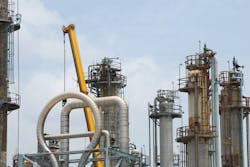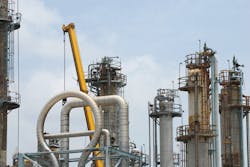Turnaround projects
Five tips to keep things in scope and on target
GEOFF ROBERTS, ORACLE, UNITED KINGDOM
IF THERE'S ANY CERTAINTY in the oil and gas industry, it's that every few years executives will spend considerable time overseeing the process of taking refinery units out of service for scheduled maintenance or unforeseen events.
These turnarounds (or TARs) are costly projects, not only because of the millions of dollars companies lose for each day a unit is out of commission, but also due to the direct costs, such as labor, tools, heavy equipment and materials that hit the bottom line. Indeed, TARs are now the most significant portion of a plant's yearly maintenance budget, according to EPCM Professional Services Partners, a US-based consultancy.
A perfectly executed project will be costly enough by itself. Unfortunately, nearly every TAR invariably involves some degree of delay. When properly planned for, the damage from such glitches can be minimized. But if anticipation of potential issues is lacking and appropriate steps are not taken to avert them, the financial effects can be significant, with critical equipment offline weeks or months longer than expected.
By and large, the traditional tools used to manage turnarounds don't provide the visibility and efficiency needed to effectively manage the agreed scope through its lifecycle. Organizations need the right combination of processes and tools in place to effectively manage this scope and mitigate risks arising from complex TAR events.
Here are five tips for improving TAR project management to improve outcomes:
Plan as if the business depends on it (because it does)
Large TARs or shutdown projects often involve thousands - sometimes tens of thousands - of activities that must be completed within a very tight, fixed window of time. Each piece of the event involves specific direct/sub contract labor resources, parts/equipment and major plants that needs to be available at certain times. All detail must be identified and scheduled in advance to ensure a smooth process and avoid costly delays.
A large refinery, for example, in addition to turnaround activities will also have thousands of day-to-day preventive maintenance activities, and several new construction or expansion projects under way - all running concurrently. A refinery's profitability largely depends on being able to quickly schedule all the above and deploy resources across projects, locations, product lines, and divisions, to ensure projects are achievable to meet the business needs. If a turnaround in one plant impacts production of a highly profitable product in another, profitability on the whole can suffer.
That's why it is critical to have a meticulous budget and timeline-driven plan that spans the entire scope of the project, from planning to execution and post-event analysis.
The most important planning consideration for TARs is to recognize most plans stumble or fail because they do not adequately prevent "scope creep," where a project's original goals expand while it is in progress. Scope creep is one of the most common causes of TAR projects going over time and budget, and it's typically driven by conflicting objectives and lack of sufficient coordination among stakeholders.
To minimize extensive scope creep, identify all project stakeholders from the start, get them engaged in planning, and ensure everyone understands and agrees to the business objectives well in advance of project kickoff. Every scope item should have at least one direct connection to the TAR business objectives. And every scope item should be tracked, compared against budget and deadlines, and mapped back into procurement.
As part of this process, it will also be important to account for unscheduled or "emergent" work in the field - that is, identifying and planning against things that might go awry during a TAR. For example, a technician might take the head off a vessel, look inside a compressor and discover it's in worse shape than expected. A solid plan will always include scenarios and fixes for emergent work. Similarly, a comprehensive plan will also anticipate and account for delays beyond control, such as an unexpected permitting problem or extreme weather conditions that could delay work.
Keep scope sacred
It's one thing to have a plan and quite another to stick to it. Too often, teams struggle with following scope throughout a project's lifecycle, frequently delivering varied results from what was originally targeted and agreed upon.
The idea of "scope freeze" - delivering on scope exactly as agreed upon at the onset - rarely works, resulting in huge costs. More often than not, the scope changes as the project progresses, chiefly due to poor planning and up-front coordination and alignment. To avoid such scenarios, it is critical to hold stakeholders accountable to commitments made during the often-lengthy planning process.
Companies must also pay close attention to the "scope-challenge" - the points in the project where requested changes are reviewed and either approved or denied. This is a good process, but many times changes are approved for the wrong reasons (often, down to who shouts the loudest). Instead, make certain all approved changes map back to the initial and agreed upon business objectives and cost-benefit analysis. And be aware of how the changes will impact project deadlines.
Make data available to all
Many oil and gas companies track project information the old-fashioned way - they plug it into a spreadsheet and standalone tools. The trouble with this approach is that critical data resides on someone's PC - where it isn't readily accessible to all stakeholders who need the data to make decisions and execute projects effectively.
With a centralized platform for project management, teams can track their work and increase overall coordination and organizational competence across the enterprise.
For example, the ability to manage scope through its lifecycle - including all estimates, reviews, approvals and any changes to the overall scope connected to the resources and schedule - ensures visibility throughout the organization. This helps ensure all stakeholders - and especially management - can make effective decisions.
In today's connected world, oil and gas companies that do not take advantage of modern integrated tools and the ability to share information in real time put themselves at a significant competitive and financial disadvantage. Transparency is key to success in the digital age.
Connect the enterprise
There are many tools and products available to support TAR events, but none delivers the kind of common, centralized project management platform that an Enterprise Project Portfolio Management (EPPM) solution does. As such, an EPPM solution should be a top consideration for oil and gas companies.
The EPPM approach eliminates the need for multiple and disparate management by spreadsheets and the like and provides accurate, up-to-date information and a bird's- eye view of project progression. For example, on a TAR there are two shifts per day, and the shift scheduler must bring all the needed data together from one shift, reconcile it, and then create the next shift plan. Managers can leverage EPPM to more effectively forecast and manage costs, schedules, materials and resources across the enterprise.
Cost, schedule, and earned-value thresholds can be set to automatically generate issues when projects exceed specified limits. Negative trends can be identified early so the necessary course corrections can be made. Managers can plan for the unexpected by performing 'what-if' simulations to determine the schedule and cost exposure of project risks. This holistic view, combined with the ability to see details when needed, provides management with the data they need to deliver the highest possible levels of predictability at the lowest possible cost.
Learn and improve continually
Far too often, the siloed and disconnected approach to TAR planning and execution leaves oil and gas companies unable to track performance and capture learnings that can be applied to future events.
On average, larger TARs occur every four to five years. Everything that occurred during previous projects - actions, incidents, scope changes, overruns, etc. - needs to be centrally stored, analyzed, and readily accessible to advise future endeavors.
TARs do not start with planning and end when specific projects are done. Organizations should view turnarounds as ongoing, circular maintenance processes that can have a direct effect on a company's revenues and competitive standing.
In conclusion, managing scope, cost, scheduling, risk and change is a core challenge for the oil and gas industry. By successfully applying these five best practices above, oil and gas companies can not only keep current TAR projects on track, but also improve the overall planning process and minimize costly delays.
ABOUT THE AUTHOR
Geoff Roberts serves as director of industry strategy (energy) at Oracle. He is a chartered cost engineer with more than 35 years of experience in all aspects of project management and project controls. He has been with Oracle Construction and Engineering for 17 years. Roberts provides strategic direction, domain expertise and insight around asset intensive industries and how they operate, to both internal and external customers and provides input into the solutions Oracle delivers to its customers.


